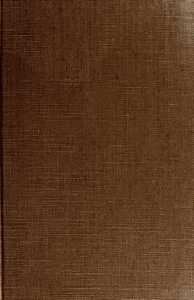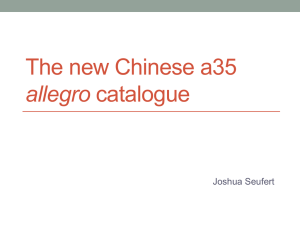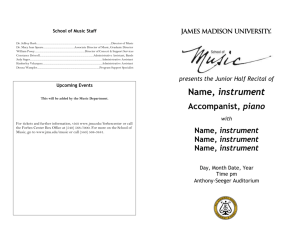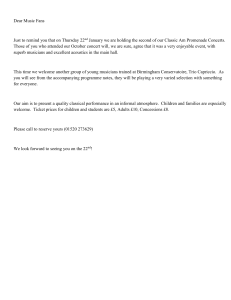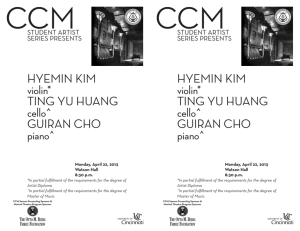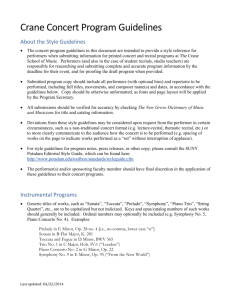HSOM Concert Program Guidelines
advertisement
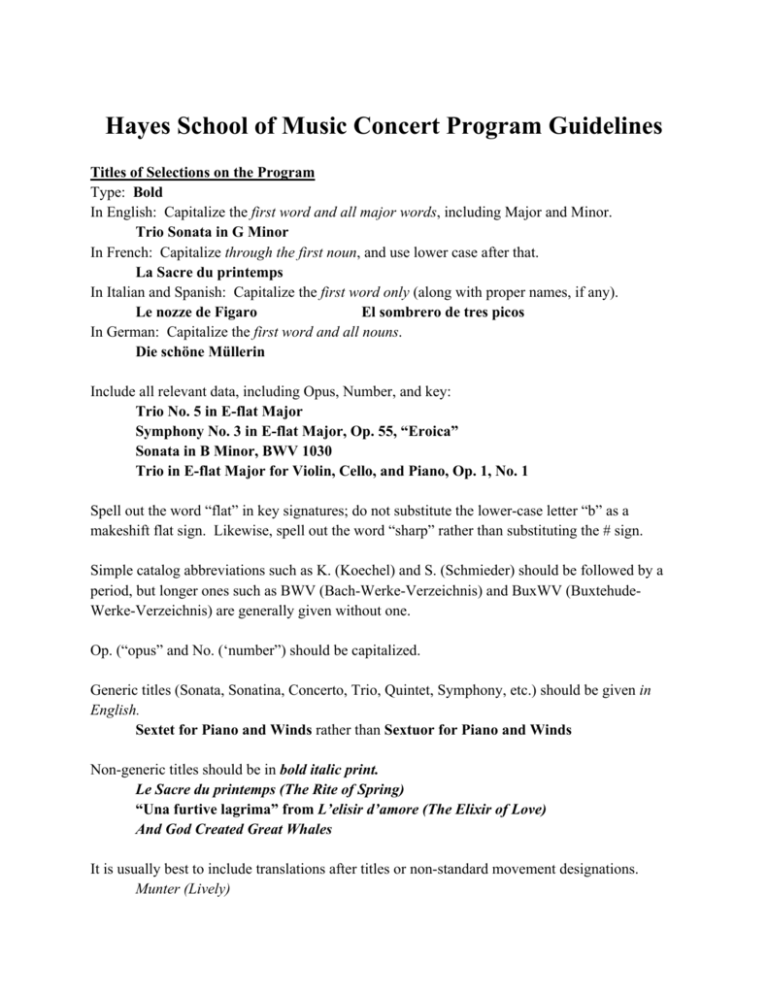
Hayes School of Music Concert Program Guidelines Titles of Selections on the Program Type: Bold In English: Capitalize the first word and all major words, including Major and Minor. Trio Sonata in G Minor In French: Capitalize through the first noun, and use lower case after that. La Sacre du printemps In Italian and Spanish: Capitalize the first word only (along with proper names, if any). Le nozze de Figaro El sombrero de tres picos In German: Capitalize the first word and all nouns. Die schöne Müllerin Include all relevant data, including Opus, Number, and key: Trio No. 5 in E-flat Major Symphony No. 3 in E-flat Major, Op. 55, “Eroica” Sonata in B Minor, BWV 1030 Trio in E-flat Major for Violin, Cello, and Piano, Op. 1, No. 1 Spell out the word “flat” in key signatures; do not substitute the lower-case letter “b” as a makeshift flat sign. Likewise, spell out the word “sharp” rather than substituting the # sign. Simple catalog abbreviations such as K. (Koechel) and S. (Schmieder) should be followed by a period, but longer ones such as BWV (Bach-Werke-Verzeichnis) and BuxWV (BuxtehudeWerke-Verzeichnis) are generally given without one. Op. (“opus” and No. (‘number”) should be capitalized. Generic titles (Sonata, Sonatina, Concerto, Trio, Quintet, Symphony, etc.) should be given in English. Sextet for Piano and Winds rather than Sextuor for Piano and Winds Non-generic titles should be in bold italic print. Le Sacre du printemps (The Rite of Spring) “Una furtive lagrima” from L’elisir d’amore (The Elixir of Love) And God Created Great Whales It is usually best to include translations after titles or non-standard movement designations. Munter (Lively) Put song and aria titles in quotation marks for selections from a larger work. “Belle nuit d’amour” from Les contes d’Hoffmann (The Tales of Hoffman) For free-standing songs, no quotation marks are necessary. Der Hirt auf dem Felsen (The Shepherd on the Rock) Always include the diacritical markings: umlauts, accents, cedillas etc. These are part of the spelling (which would be incorrect without them). Francois-René Gebauer Eugène Bozza Béla Bartók Bohuslav Martinů Die schöne Müllerin Dates of Works Type: Regular You may include the date of composition in parentheses directly following the title if you wish. Contrasts (1938) Composers’ Names Type: Bold Spell out composers’ names. Do not use initials, even if you think the composer’s name is too long to fit on the same line as the title (Ex. Jacques-Martin Hotteterre “le Romain”). If the title and the composer combined are too long to fit on the same line, put the composer’s name on the next lower line. Degrees of Variation for Trombone and Computer Generated Sounds (2003) Reginald Bain Movement Titles Type: Italics If you are performing all the movements or all the individual songs within a work, it is not necessary to indicate the movement numerals, but you may do so if you wish. If you are performing some, but not all, of the movements, then do include the movement numeral (we use Roman numerals for this). Concerto in D Major, Op. 61 II. Larghetto III. Rondo: Allegro Capitalization in movement titles follows the rules of the language itself. I. Allegro moderato II. Andantino grazioso III. Minuetto: Allegro Why is the “Allegro portion of “Minuetto: Allegro” capitalized, when “moderato” and “grazioso” are not? It is because “moderato” and “grazioso” in these titles function as adjectives, whereas the third movement essentially has two titles: the dance (Minuetto) and the tempo (Allegro). Punctuation within movement titles: Use a colon to combine a dance movement or the Finale with a tempo designation. Minuetto: Allegro Rondo: Allegro Finale: Allegro con spirit Use a dash to separate two or more distinct sections within a movement. Adagio—Allegro Adagio—Allegro con spirit—Adagio Composers’ Dates Type: Regular For living composers, give birth year. (b. 1944) For composers with approximate dates, use c. (“circa”) in italics. (c. 1505-1585) For composers with a date of death only, use the following format. (d. c. 1502) Sometimes, fl. (floruit; “flourished”) is used. (fl. Early 17th century) Arrangers’ and Transcribers’ Names Type: Regular The arranger’s or transcriber’s name, when present, is given directly underneath the composer’s dates and can be listed either as “arranged by” or simply “arr.”) “transcribed by” or simply “trans.”) Tomaso Albinoni (1671-1751) arr. Douglas Yeo If you are performing a special edition of the work and wish to acknowledge the editor, use the abbreviation “ed.” in the same way you would cite an arranger. Note: Music publishers are not always as attentive to detail or as consistent as they should be, so you might find that the capitalization and punctuation appear differently in your sheet music. Please use these guidelines here, which reflect standard practices among professional ensemble and scholarly music journals in the U.S.
